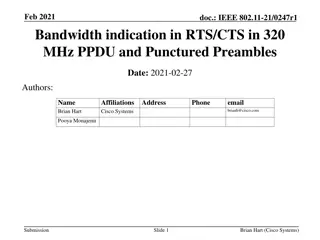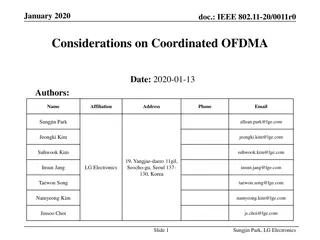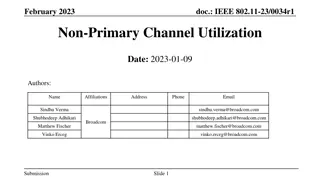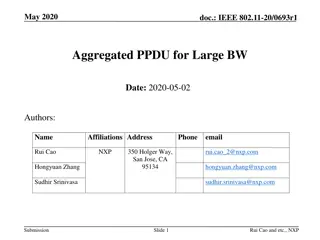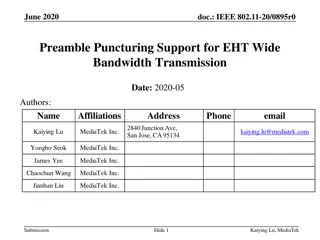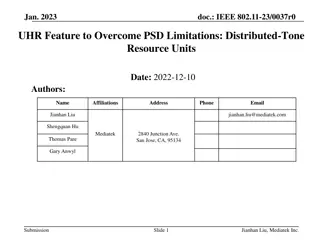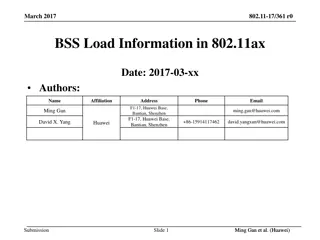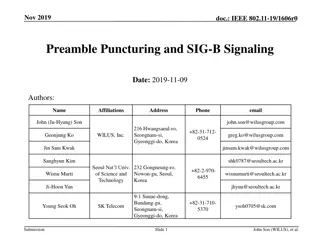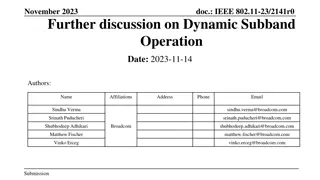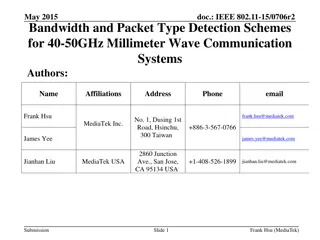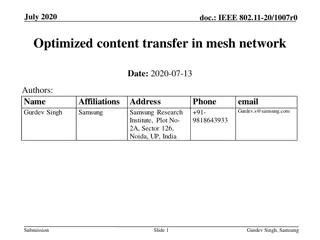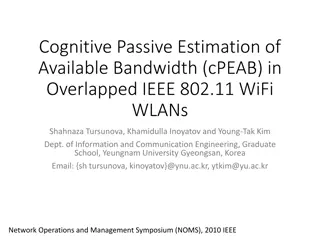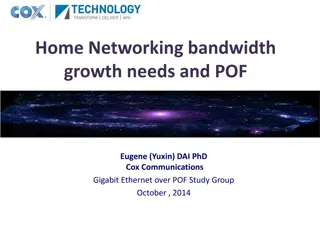Enhancing Support for Wider Bandwidth OFDMA in IEEE 802.11 Networks
The document discusses the implementation of Selective Spatial Transmission (SST) and Dynamic Subband Operation (DSO) to enable wider bandwidth OFDMA in IEEE 802.11be and 802.11bn standards. It covers enhancements for 80MHz, 160MHz, and 320MHz EHT DL and UL OFDMA transmissions, emphasizing the benefits of A-PPDU for increased data rates and reduced latency. Various A-PPDU combination examples are provided to illustrate efficient utilization of wider bandwidth channels. Hardware requirements, SST extension to secondary 160MHz, and the potential for static and dynamic preamble puncturing are explored, highlighting the evolution of non-AP STA capabilities in modern wireless networks.
Download Presentation

Please find below an Image/Link to download the presentation.
The content on the website is provided AS IS for your information and personal use only. It may not be sold, licensed, or shared on other websites without obtaining consent from the author. Download presentation by click this link. If you encounter any issues during the download, it is possible that the publisher has removed the file from their server.
E N D
Presentation Transcript
July 2024 Doc.: IEEE 802.11-24/1244r0 SST or DSO Support for Wider Bandwidth OFDMA and A-PPDU Date: 2024-07-12 Authors: Affiliations Address Phone email Name Ross Jian Yu ross.yujian@huawei.com Ming Gan David Xun Yang Huawei Submission Slide 1 Ross Jian Yu, et al Huawei Technologies
July 2024 Doc.: IEEE 802.11-24/1244r0 SST for Wider Bandwidth OFDMA in 802.11be In 11be, an 80 MHz operating non-AP EHT STA shall be able to participate in 160MHz, and 320MHz EHT DL and UL OFDMA transmissions. Several features are designed accordingly, for example, a receiver only needs to process preambles within its operating 80 MHz channel. However, there is not enough support to enable wider bandwidth OFDMA. Only HE subchannel selective transmission (SST) is supported. NOTE 2 As defined in 35.11.4 (CENTER_FREQUENCY_SEGMENT), an 80 MHz operating non-AP EHT STA operates in the primary 80 MHz channel and might operate in the secondary 80 MHz channel that does not include any inactive 20 MHz subchannel when the 80 MHz operating non-AP EHT STA sets dot11HESubchannelSelectiveTransmissionImplemented to true. SST is not supported in secondary 160 MHz or when preamble puncturing exists in secondary 80 MHz. Submission Slide 2 Ross Jian Yu, et al Huawei Technologies
July 2024 Doc.: IEEE 802.11-24/1244r0 Wider Bandwidth OFDMA in 802.11bn For 802.11bn, SST should be extended to secondary 160 MHz and preamble puncturing case. For example, one additional octet of bitmap for secondary 160 MHz. For preamble puncturing, may consider static preamble puncturing as a baseline, and further study dynamic preamble puncturing. SST is combined with TWT, and doesn t have tight hardware requirements for the non-AP STA. Parks on the channel in the SP phase and waits for AP scheduling information. SP STA(s) in doze TWT request(s) TWT response(s) P20MHz STA(s) AP Dynamic subband operation (DSO), which moves non-AP STAs to secondary channels at the beginning of a TXOP, may also be applied. However, this requires tighter hardware requirements, and need more evaluation and discussions. Slide 3 Submission Ross Jian Yu, et al Huawei Technologies
July 2024 Doc.: IEEE 802.11-24/1244r0 A-PPDU Frequency domain A-PPDU has been well discussed in 802.11be and also in [4-7] in 802.11bn. A-PPDU can further take advantage of the wider bandwidth channels when there are legacy transmissions. ~2x data rate improvement for 80 MHz 160 MHz or 160 MHz 320 MHz transmission, ~4x data rate improvement for 80 MHz 320 MHz transmissions. Reduce latency compared with only legacy transmissions in primary channel. A-PPDU can be supported when there are large bandwidth capable non-AP STAs (e.g. 160 or 320 MHz non-AP STA), without SST or DSO. With SST or DSO support, A-PPDU can also be enabled for bandwidth limited non-AP STAs or smaller bandwidth operating non-AP STAs. Several A-PPDU combination examples are shown in the following slides. The preferred modes are marked in red. Whilst we are open for specific modes. Submission Slide 4 Ross Jian Yu, et al Huawei Technologies
July 2024 Doc.: IEEE 802.11-24/1244r0 A-PPDU Combination Examples 80 MHz 80 MHz HE PPDU EHT PPDU HE PPDU (by UHR STA) UHR PPDU (1) (2) 160 MHz HE PPDU EHT PPDU HE PPDU 160 MHz UHR PPDU EHT PPDU (by UHR STA) UHR PPDU (a) (b) (c) 80 MHz 80 MHz HE PPDU EHT PPDU HE PPDU HE PPDU (by UHR STA) EHT PPDU (by UHR STA) HE PPDU (by UHR STA) 160 MHz UHR PPDU UHR PPDU EHT PPDU (by UHR STA) (d) (e) (f) Submission Slide 5 Ross Jian Yu, et al Huawei Technologies
July 2024 Doc.: IEEE 802.11-24/1244r0 TB A-PPDU in 11be In 802.11be, the trigger frame can support an A-PPDU of HE TB PPDU and EHT TB PPDU whilst the spec disallows the AP to do that. An EHT non-AP STA might respond if triggered by an AP of later generations. Trigger frame 160 MHz HE TB PPDU EHT TB PPDU (BW=320MHz-1/2) 160 MHz Non-HT Duplicate B54 is set to 1 to indicate HE TB PPDU in P160, B55 is set to 0 to indicate presence of Special User Info field, which indicates EHT TB PPDU exists. Then in User Info field, B39 is set to 0 to indicate P160, which means HE variant User Info field, B39 is set to 1 to indicate S160, which means EHT variant User Info field. Submission Slide 6 Ross Jian Yu, et al Huawei Technologies
July 2024 Doc.: IEEE 802.11-24/1244r0 TB A-PPDU in 11bn If we allow a UHR AP can use the last two rows, then TB A-PPDU of HE TB PPDU and EHT TB PPDU is doable with no further efforts. HE non-AP STA and EHT non-AP STA can transmit HE TB PPDU, UHR non-AP STA can transmit EHT TB PPDU. EHT non-AP STA may also participate in EHT TB PPDU if there is no interoperability issue. Furthermore, if PHY Version Identifier is set to UHR, then TB A-PPDU of HE TB PPDU and UHR TB PPDU is straightly doable. Trigger frame 160 MHz HE TB PPDU UHR TB PPDU (BW=320MHz-1/2) 160 MHz Non-HT Duplicate Other modes need some further works. With DL A-PPDU, the signaling of TB A-PPDU can be further simplified. Submission Slide 7 Ross Jian Yu, et al Huawei Technologies
July 2024 Doc.: IEEE 802.11-24/1244r0 DL(non-TB) A-PPDU in 11bn DL A-PPDU is not discussed in detail in 11be. Within A-PPDU, each PPDU indicates its own bandwidth and parameters. Moreover, the aggregated bandwidth, or exact bandwidth combinations may also be signaled (needs further study). HE MU- 1 HE-SIG-A BW=80MHz L-STF L-LTF L-SIG RL-SIG HE-SIG-B HE-STF HE-LTF Data PE HE MU- 2 HE-SIG-A BW=80MHz L-STF L-LTF L-SIG RL-SIG HE-SIG-B HE-STF HE-LTF Data PE UHR MU- 3 U-SIG BW=160MHz UHR- STF L-STF L-LTF L-SIG RL-SIG UHR-SIG UHR-LTF Data PE Submission Slide 8 Ross Jian Yu, et al Huawei Technologies
July 2024 Doc.: IEEE 802.11-24/1244r0 Summary In this contribution, we first discuss the enhancement of SST or DSO, which can support both wider bandwidth OFDMA and A-PPDU. We further discuss the advantages and some details on A-PPDU, for both TB or non-TB cases. Submission Slide 9 Ross Jian Yu, et al Huawei Technologies
July 2024 Doc.: IEEE 802.11-24/1244r0 Straw Poll #1 Do you agree to include the following into the 11bn SFD? 11bn supports subchannel selective transmission for secondary 160 MHz channel. Y N A Submission Slide 10 Ross Jian Yu, et al Huawei Technologies
July 2024 Doc.: IEEE 802.11-24/1244r0 Straw Poll #2 Do you agree to include the following into the 11bn SFD? 11bn supports subchannel selective transmission when there exists static preamble puncturing. Dynamic preamble puncturing case is TBD Y N A Submission Slide 11 Ross Jian Yu, et al Huawei Technologies
July 2024 Doc.: IEEE 802.11-24/1244r0 Motion #1 Do you agree to include the following into the 11bn SFD? 11bn defines frequency domain aggregation of aggregated PPDUs. A frequency domain aggregated PPDU consists of multiple PPDUs. The PPDU format combinations include HE PPDU, other PPDUs are TBD. The number of PPDUs is TBD. Y N A Submission Slide 12 Ross Jian Yu, et al Huawei Technologies
July 2024 Doc.: IEEE 802.11-24/1244r0 Straw Poll #3 Do you agree to include the following into the 11bn SFD? 11bn defines frequency domain aggregation of a 160 MHz HE PPDU and 160 MHz UHR PPDU. Y N A Submission Slide 13 Ross Jian Yu, et al Huawei Technologies
July 2024 Doc.: IEEE 802.11-24/1244r0 Straw Poll #4 Do you agree to include the following into the 11bn SFD? 11bn defines frequency domain aggregation of an 80 MHz HE PPDU, 80 MHz HE PPDU and 160 MHz UHR PPDU. Y N A Submission Slide 14 Ross Jian Yu, et al Huawei Technologies
July 2024 Doc.: IEEE 802.11-24/1244r0 References 1. IEEE Std 802.11axTM-2021 2. Draft P802.11be D6.0 3. https://mentor.ieee.org/802.11/dcn/21/11-21-0015-00-00be-clarification-of- 80-mhz-operation-in-wider-bw-ofdma.pptx 4. https://mentor.ieee.org/802.11/dcn/23/11-23-1865-01-00bn-discussion-on- sst-and-a-ppdu.pptx 5. https://mentor.ieee.org/802.11/dcn/24/11-24-0224-02-00bn-discussion-on-a- ppdu-follow-up.pptx 6. https://mentor.ieee.org/802.11/dcn/23/11-23-1954-00-00bn-two- dimensional-a-ppdu.pptx 7. https://mentor.ieee.org/802.11/dcn/24/11-24-0001-01-00bn-dl-mu-ext- ppdus.pptx Submission Slide 15 Ross Jian Yu, et al Huawei Technologies
July 2024 Doc.: IEEE 802.11-24/1244r0 Appendix Individual TWT Operation Submission Slide 16 Ross Jian Yu, et al Huawei Technologies
July 2024 Doc.: IEEE 802.11-24/1244r0 Agreed SPs for 11be R2 [1] Submission Slide 17 Ross Jian Yu, et al Huawei Technologies
July 2024 Doc.: IEEE 802.11-24/1244r0 Agreed SPs for 11be R2 [1] Submission Slide 18 Ross Jian Yu, et al Huawei Technologies





